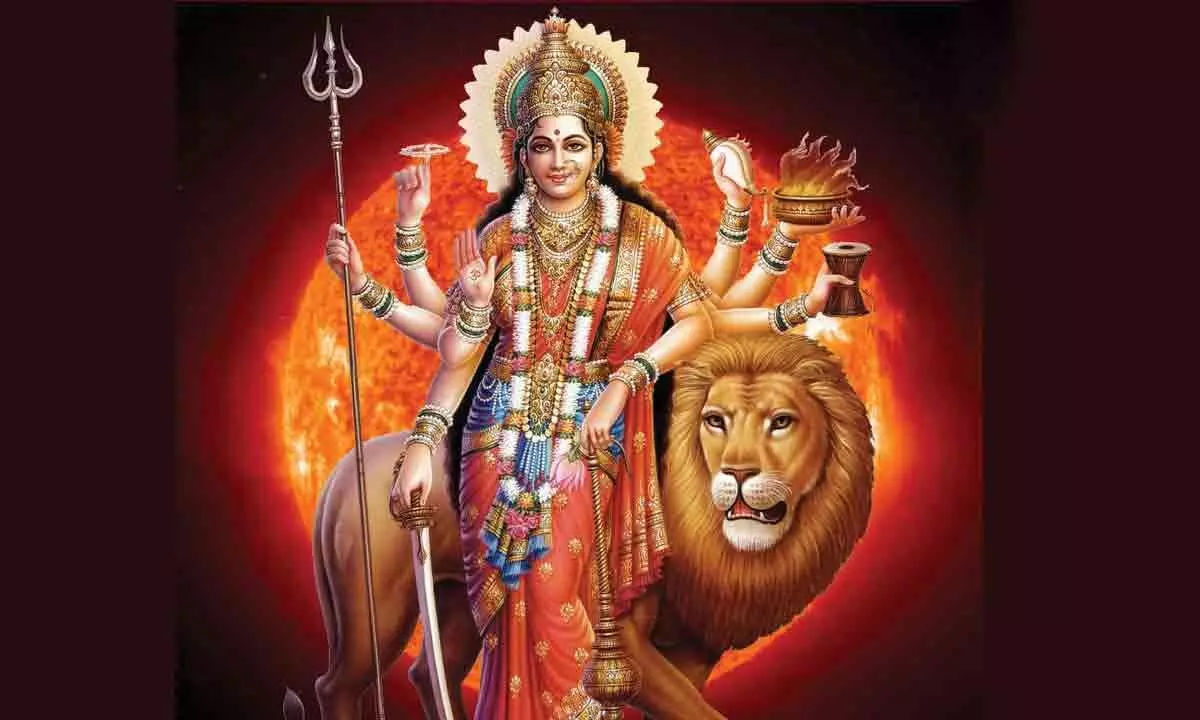Worshipping Devi

An important period in the annual spiritual calendar started today. The period of ten days and nine nights means different things to different people. It is a matter of celebration for many, but for some, it is a period for study. The Supreme Reality is visualised in the form of mother and worshipped
An important period in the annual spiritual calendar started today. The period of ten days and nine nights means different things to different people.
An important period in the annual spiritual calendar started today. The period of ten days and nine nights means different things to different people. It is a matter of celebration for many, but for some, it is a period for study. The Supreme Reality is visualised in the form of mother and worshipped.
In all such visualisations, the philosophical content, which is from the Upanishads, does not change. It is the same Brahman, and the same manifesting power, Shakti, which transforms into the universe with its three gunas – sattva, rajas and tamas, creating the diversity, conflicts, disorders, and restoration of order. A student of Vedanta sees it as a beautiful play of the gunas. Sages weave different stories to illustrate this dramatically. One such is the story in the Devi Saptashati, which is read during these ten days. The inner growth of a seeker is like a battle, starting with vanquishing one’s lethargy (tamas). This victory leads to creativity, prosperity, but it also leads to pomp, arrogance, and indulgence in sensual pleasures. This is rajas, which must be vanquished by sattva guna, which involves practice of spiritual discipline and study of scriptures.
The seeker is not content with this. His/her highest goal is to become one with Brahman. Just as the Brahman is beyond the three gunas, the seeker too has to transcend the three gunas, lose his/her identity in the identity of Brahman. For this, even the sattva guna has to be overcome. This inner struggle is projected at the cosmic level as the struggle between gods and demons.
The text starts with a discussion on what is self-knowledge. The teacher is a sage, and the students are a king and a merchant. The sage tells what knowledge is and then tells three stories which describe the inner battle which the seeker has to do. The first is about conquering lethargy. Two demons Madhu (honey/intoxicant) and Kaitabha (insect) signify dullness. They do not like activity and hence try to eat Brahma, the creator. Vishnu comes to his rescue, battles with the two demons and kills them. Brahma is free to create.
The second story is about a demon named Mahisha (buffalo) and his attendant demons. They are those who vanquish the whole world, seize the powers of all gods, and have all the best in the world for themselves. Mahisha ascends the throne of Indra. In Vedanta literature, gods mean the presiding deities of our sense organs and organs of action. For example, Indra is the lord of all senses, Sun is the presiding deity of the eye, Agni (fire) is the deity of speech, Moon is the deity of the mind and so on. Seizing powers of Indra and gods means that all our senses are abducted and kept tied to sensual pleasures. Mahisha, the buffalo is the mighty ego and his attendant demons are the six deadly allies, kama (lust), krodha (anger), lobha (greed) and so on, all of whom we know. Such an unbridled ego has to be curbed. The Devi appears in her fierce form and battles with the forces of Mahisha. Mahisha is our own self when ego takes over. The divine mother helps the seeker and comes to his help. There is a blow-by-blow account of how ego wants to defeat the divine Mother, but the mother cannot allow such demons to thrive. Mahisha and his fellow demons are killed.
Now we come to the phase in which sattva presents a more formidable ego, an enemy of enlightenment. Ego says, ‘I am an enlightened person, I am the wisest person I have to be worshipped by all’. This can be vanquished only by the right knowledge. Hence, Saraswati, the goddess of learning, is the prime deity in this story. She appears in several forms to defeat several tricks played by the ego. The twin demon brothers signify spiritual pride. In their arrogance, they wish to marry the divine mother. The killing of the demons signifies the elimination of the ego. The bliss of divinity is experienced only when the ego is totally vanquished. This is the bare outline of a long story which describes the many tricks of the intellect.
Even if a trace of ego remains, it rises again. This is shown as a demon, Rakta-bija, meaning ‘blood-seed’. With every drop of blood falling on the ground, a demon of equal strength arises. The goddess spreads out her tongue to cover the whole earth and swallows every drop so that no blood falls on the ground. This is one of the most misunderstood stories in our puranas, with ignorant critics accusing that the Hindu deities are blood thirsty.
Most of our stories are for contemplation on self, to watch the demonic traits in us and vanquish them.
(The writer is a former DGP, Andhra Pradesh)
















